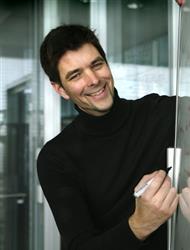ProjektEntwicklung funktional leistungsfähiger und biologisch realistischer Modelle der neuronalen Signalverarbeitung
Grunddaten
Titel:
Entwicklung funktional leistungsfähiger und biologisch realistischer Modelle der neuronalen Signalverarbeitung
Laufzeit:
01.01.2016 bis 31.12.2017
Abstract / Kurz- beschreibung:
Wie Informationen in den Nervenzellen des Gehirns repräsentiert, kombiniert und manipuliert werden, ist eine der grundlegenden Fragen der Neurowissenschaften. Eine Antwort wird stark erschwert durch die Stochastizität neuronaler Aktivierungen: selbst identische Stimulierung führt zu unterschiedlichen Aktivitätsmustern. Der Ursprung dieses Rauschens sowie ihre Auswirkungen sind nur schwer experimentell zugänglich und bis heute umstritten. Insbesondere zeichnen die bisherigen, stark vereinfachten theoretischen Modelle ein widersprüchliches Bild, im Zuge dessen der Zusammenhang zwischen Rauschen und verschiedenen Wahrnehmungsleistungen nach wie vor ungeklärt ist. Insbesondere vernachlässigen bisherige Modelle die hierarchische Struktur und funktionsoptimierte Konnektivität des Neokortex. Neue Ansätze, die diesen Merkmalen Rechnung tragen, eröffnen die Möglichkeit, ein grundlegendes und belastbares Verständnis der Struktur neuronaler Signalkodierung und deren Einfluss auf die Wahrnehmungsleistungen zu gewinnen.
Im Rahmen dieses Projekts wollen wir die jüngsten Durchbrüche im Bereich des maschinellen Lernens und selbst-organisierter Netzwerke zur Entwicklung neuer Populationsmodelle nutzen. Zu diesem Zweck verallgemeinern wir ein leistungsfähiges, hierarchisch strukturiertes Netzwerkmodell (mit herausragenden perzeptuellen Fähigkeiten wie Objekterkennung) und vergleichen systemneurowissenschaftliche Informationsanalysen mit Ergebnissen etablierter Modelle. Im Anschluss passen wir dieses Basismodell sukzessive den biophysikalischen Randbedingungen an, unter denen der Neokortex operiert, und vergleichen Vorhersagen des Modells mit experimentellen Messungen.
Im Rahmen dieses Projekts wollen wir die jüngsten Durchbrüche im Bereich des maschinellen Lernens und selbst-organisierter Netzwerke zur Entwicklung neuer Populationsmodelle nutzen. Zu diesem Zweck verallgemeinern wir ein leistungsfähiges, hierarchisch strukturiertes Netzwerkmodell (mit herausragenden perzeptuellen Fähigkeiten wie Objekterkennung) und vergleichen systemneurowissenschaftliche Informationsanalysen mit Ergebnissen etablierter Modelle. Im Anschluss passen wir dieses Basismodell sukzessive den biophysikalischen Randbedingungen an, unter denen der Neokortex operiert, und vergleichen Vorhersagen des Modells mit experimentellen Messungen.
Schlüsselwörter:
rauschkorrelation (noise correlation)
barrel cortex (barrel cortex)
Signalverarbeitung
signal processing
neuronale Netze
neural networks
Selbstorganisation
self-organisation
Beteiligte Mitarbeiter/innen
Leiter/innen
Brendel, Wieland
Neurologische Universitätsklinik
Kliniken und klinische Institute, Medizinische Fakultät
Kliniken und klinische Institute, Medizinische Fakultät
Ansprechpartner/innen
Mathematisch-Naturwissenschaftliche Fakultät
Universität Tübingen
Universität Tübingen
Institut für Theoretische Physik (ITP)
Fachbereich Physik, Mathematisch-Naturwissenschaftliche Fakultät
Fachbereich Physik, Mathematisch-Naturwissenschaftliche Fakultät
SFB 1233 - Robustheit des Sehens – Prinzipien der Inferenz und der neuronalen Mechanismen
Sonderforschungsbereiche und Transregios
Sonderforschungsbereiche und Transregios
Bernstein Center for Computational Neuroscience Tübingen (BCCN)
Interfakultäre Institute
Interfakultäre Institute
Tübingen AI Center
Fachbereich Informatik, Mathematisch-Naturwissenschaftliche Fakultät
Fachbereich Informatik, Mathematisch-Naturwissenschaftliche Fakultät
Lokale Einrichtungen
Werner Reichardt Centrum für Integrative Neurowissenschaften (CIN)
Zentren oder interfakultäre wissenschaftliche Einrichtungen
Universität Tübingen
Universität Tübingen
Geldgeber
Stuttgart, Baden-Württemberg, Deutschland


